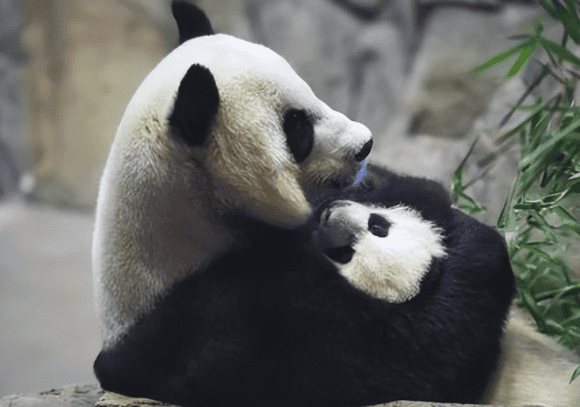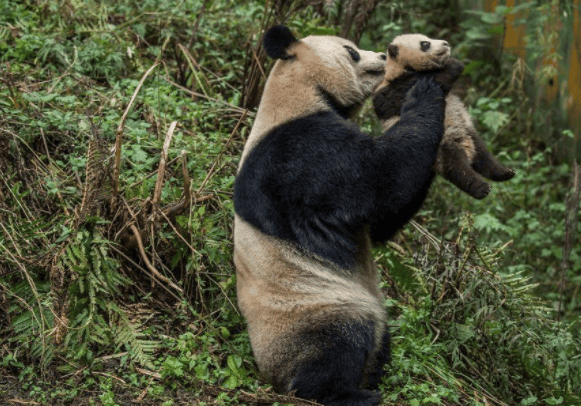Pandas have very weak survivability and are slow to move. They can fall down even if they climb a tree. Moreover, their fertility desire and sperm survival rate are very low. Why can they survive for millions of years without becoming extinct?
In fact, the survival ability of pandas is indeed worrying. The estrus period of female giant pandas is very short. They only go into estrus once a year from March to May, and each time lasts only 2-3 days.
After mating is completed, the male and female giant pandas will live separately again. Heavy tasks such as pregnancy, childbirth, and childcare are all completed by the female giant panda alone.

At the same time, panda babies themselves are relatively fragile and are prone to illness and death. Coupled with the phenomenon of inbreeding, some panda babies may have deformities.
In terms of survival, some people say that wild giant pandas are not as lazy and clumsy as those in zoos, and have better survival capabilities. In fact, wild giant pandas suffer from many diseases, the main disease leading to their death is failure caused by malnutrition.
Secondly, the digestive system of pandas that transitioned from carnivorous habits is still unable to digest some rough bamboos well, so that the intestines and stomach may be scratched by bamboos, causing symptoms such as gastroenteritis and bleeding.
Finally, there are diseases caused by parasites such as ascariasis and mites. Scientists have discovered that the roundworm infection rate in giant pandas in the wild has reached an astonishing 100%!
One wild giant panda was even infected with 1,605 roundworms! Infection with mange in giant pandas can also cause a series of skin diseases, which may cause death of cubs if infected.
In addition, judging from researchers' overall research on pandas, they seem to have entered an evolutionary dead end.
First of all, in terms of feeding habits, the ancestors of giant pandas ate meat, but because they could not compete with other carnivorous animals, the herbivorous ecological niche was occupied by other animals.

It accidentally discovered that bamboo is a food that no animal can eat, so a genetic mutation occurred and the gene for eating bamboo was passed on.
Research shows that giant pandas learned to eat bamboo at least 6 million years ago. To this day, giant pandas still have "pseudogenes" representing their meat-eating habits.
The so-called pseudogenes are true genes that may have actual functions a long time ago. However, due to long-term evolution, the functions of such genes gradually become redundant or even harmful, so the body begins to slowly eliminate these genes. Gene-like, but the base sequence of the gene itself still remains on the genome.
So the DNA sequence of a pseudogene is usually similar to the corresponding gene, but in fact it has lost at least part of its original function. For example, the protein encoded by the gene has no function.
Among these pseudogenes is the umami taste receptor gene TAS1R1, which is used to sense the taste of meat, but now they exist in name only.
In addition, in order to better eat bamboo, giant pandas have also evolved many "unique skills", and false thumb is one of them.
In addition to the five fingers found on the forelimbs of most mammals, the giant panda also has a strongly enlarged bone protrusion on the wrist, which acts as a sixth finger, forming a hand with certain grasping capabilities. palm.

Although pandas' crude hands cannot pick seeds, nuts and berries like primates, they are at least very good at grasping bamboo.
By studying the changes in the palms of panda fossils, archaeologists and biologists have found the approximate time when they ate bamboo.
However, although eating bamboo allows giant pandas to have almost no competitors in this ecological niche, and they can lie down without having to continue to stay in the carnivore group, eating bamboo also brings them The hidden danger of low fault tolerance rate is eliminated.
That is to say, the living conditions of giant pandas are too harsh. If they leave southwest China, or the bamboo suddenly disappears, they are very likely to become extinct.
In fact, in the past few decades, this trend has already formed after the rapid development of human society caused damage to the natural world.
Fortunately, we established a giant panda nature reserve and a giant panda sperm bank in time to actively protect and help giant pandas breed and treat their diseases, so the situation improved.
Overall, the evolution of giant pandas is indeed very targeted, which has allowed them to live for more than 6 million years, and can even be said to live freely and carefree.
However, in order to make up for the lack of energy and nutrition in bamboo, they reduce their ability to carry out daily activities. Generally, the total distance of activities per hour is only about 20 meters.
This makes the metabolism rate of pandas reach an extremely low level. The metabolism level of a giant panda weighing 90kg is less than half that of an adult of the same weight.
The path of this evolutionary direction is becoming narrower and narrower. In the past, giant pandas could give up their right to eat meat, their flexible mobility and their ability to hunt prey, because this was their inherent ability. , it’s easy to give up.
But once the climate or environment changes drastically, it will be very difficult for them to learn to move quickly and hunt again. Therefore, if that day really comes, it will be difficult for giant pandas to evolve their ability to adapt to the new era. The chance of survival will approach zero. This is one of the reasons why we always think that giant pandas should be extinct.

 扫一扫微信交流
扫一扫微信交流
发布评论